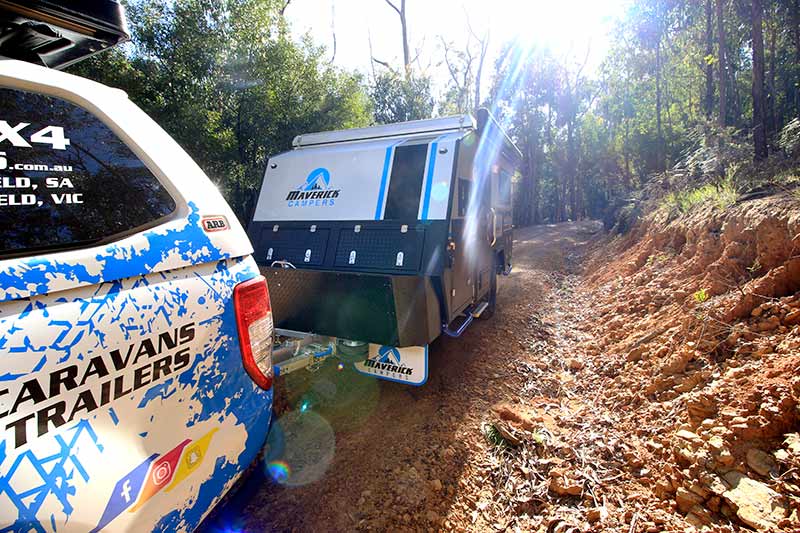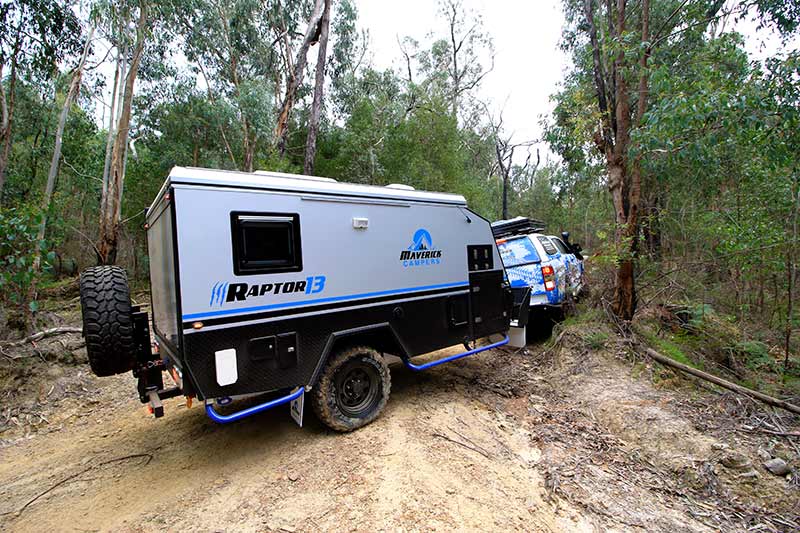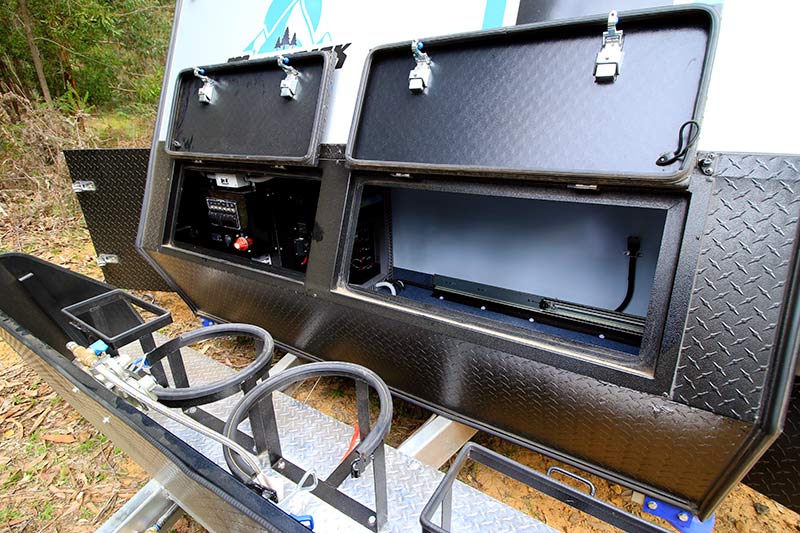South Australia-based Maverick Campers had travelled under my radar until relatively recently.
Maverick’s Raptor 13 came into my life in mid-March. With its grey composite aluminium cladding over an aluminium frame, 16in alloys wheels and high black checkerplate protection, I was immediately intrigued – it’s a hybrid compact pop-top designed for offroad work.
The Raptor range is built overseas and imported for the Australian market. There are five models in the range, starting with the diminutive Raptor 11, which has a travel length of 5.42m. With its travel length of 6.95m, the Raptor 17 is the top-end model.
 Our Maverick Campers Raptor 13 was one size up from the 11. At 6.16m from the coupling to the rear spare wheel carriers, it packs a pretty decent punch. Hitched to Maverick’s company Ford Ranger, we hauled it through bushland in northern Victoria, along tight gravel tracks, through deep ruts and up treacherous embankments.
Our Maverick Campers Raptor 13 was one size up from the 11. At 6.16m from the coupling to the rear spare wheel carriers, it packs a pretty decent punch. Hitched to Maverick’s company Ford Ranger, we hauled it through bushland in northern Victoria, along tight gravel tracks, through deep ruts and up treacherous embankments.
SETTING UP THE MAVERICK CAMPERS RAPTOR 13
The Raptor 13 has an extendable bed area that takes a couple of minutes to set-up once you’re at camp. It’s a matter of lowering the dual spare wheel carriers, and unlatching the rear wall, which folds up to a horizontal position to become a bedroom roof.
Behind the rear wall, you’ll find two doors. Unlatch them and fold them outwards so that they become the bedroom’s side walls. Another section folds down to become the floor. Each of these aluminium pieces latch tightly together.
 The pop-top roof raises in the conventional way – undo four over-centre catches, step inside and lift both ends. You can then position the bedroom’s mattress.
The pop-top roof raises in the conventional way – undo four over-centre catches, step inside and lift both ends. You can then position the bedroom’s mattress.
It is not a unique design or interior layout but it appears to have been executed well in the Maverick Campers Raptor 13. The fold-out bed is, in particular, a great idea. It’s similar to what you’d find on an Expanda-style of caravan with the benefit of hard walls rather than canvas.
I was particularly pleased with the storage options available on this caravan. It includes a small tunnel boot towards the front and an excellent drawer system on the offside.
 The nose of the van is fitted with dual hatches to provide access to the van’s 12V nerve centre. Here, you’ll find switches for all electrical appliances that allow you to isolate things like the lights, the fridge and the hot water system. A 1000W optional inverter was also fitted as part of the Options Pack, which also includes three 100W solar panels and a third 100Ah AGM batteries. A 20A battery charger is fitted, too.
The nose of the van is fitted with dual hatches to provide access to the van’s 12V nerve centre. Here, you’ll find switches for all electrical appliances that allow you to isolate things like the lights, the fridge and the hot water system. A 1000W optional inverter was also fitted as part of the Options Pack, which also includes three 100W solar panels and a third 100Ah AGM batteries. A 20A battery charger is fitted, too.
While you could no doubt pick and choose the options you’d like to fit, the Options Pack at around $3000 appears to be good value for money. As well as the above, it includes features such as the excellent McHitch offroad coupling, a Truma hot water service, and the versatile Ark XO 750 jockey wheel – this is a great piece of equipment that makes hitching and unhitching the van on uneven terrain much easier than a standard jockey wheel.
 Due to the compact internal layout, the focus is on external living. To that end, the Raptor 13 has been equipped with a neat slide-out rear kitchen that sports a fold-up shelving unit, hot and cold water and a couple of drawers. The sink is permanently hooked to the van’s water supply, so there’s no need to muck around with hoses. You will need to hook to the van’s gas supply, though, via the nearby bayonet coupling.
Due to the compact internal layout, the focus is on external living. To that end, the Raptor 13 has been equipped with a neat slide-out rear kitchen that sports a fold-up shelving unit, hot and cold water and a couple of drawers. The sink is permanently hooked to the van’s water supply, so there’s no need to muck around with hoses. You will need to hook to the van’s gas supply, though, via the nearby bayonet coupling.
In terms of refrigeration, the van is limited to an external portable unit on a forward slide-out. Our van was fitted with an 85L MyCoolman unit, but many options are available in this department.
The van is equipped with independent coil suspension with two shock absorbers per wheel. The chassis is a galvanised box section construction with 6in rails (150x50x3mm).
As we negotiated ruts and steep undulations, the van didn’t bounce too aggressively and nothing broke. I was interested to note how its compact length aids its departure angle – a rear cutaway isn’t necessary here. But I was glad the rig had scrub rails as the Ranger hauled it unnervingly close to outcrops of rock and compacted gravel.
 In terms of self-sufficiency, the Raptor 13 gets dual 9kg gas cylinders on the drawbar (protected by a mesh stoneguard) as standard, along with two 85L water tanks and a separate 30L water tank, giving it a total of 200L.
In terms of self-sufficiency, the Raptor 13 gets dual 9kg gas cylinders on the drawbar (protected by a mesh stoneguard) as standard, along with two 85L water tanks and a separate 30L water tank, giving it a total of 200L.
RAPTOR’S LAYOUT
General living space is quite limited inside the Raptor 13, but that’s the nature of this particular beast. It is designed to be compact, light and practical for genuine offroad conditions.
This doesn’t mean, however, that it’s not comfortable or that it doesn’t offer the essentials. Quite the contrary.
 The bed fills the rear of the van, while a surprisingly large storage unit fills the offside wall between the bed and the corner combo bathroom. A shelf with cabinets fills out the front while a small two-seater lounge occupies the nearside.
The bed fills the rear of the van, while a surprisingly large storage unit fills the offside wall between the bed and the corner combo bathroom. A shelf with cabinets fills out the front while a small two-seater lounge occupies the nearside.
To the left of the entrance, you’ll find 12V points and three water level indicators. At floor level, to the right, was the sound system fitted as part of the Options Pack.
The general fitout appears quite good; however, one or two joins could have been tighter, such as where the front bench meets the wall. That said, other areas exceeded expectations.
 The batteries are mounted out of the way under the mattress, as is the hot water service, which makes sense as these are low-service items requiring little attention.
The batteries are mounted out of the way under the mattress, as is the hot water service, which makes sense as these are low-service items requiring little attention.
It is, overall, an ‘easy to use’ hybrid camper, from the relatively quick set-up to the kitchen that’s always plumbed to water. Even the awning is electric – just push a button and out it comes.
During my time with the Maverick Campers Raptor 13, I developed the opinion that it would travel more or less anywhere the 4WD could go. It wasn’t troubled in the slightest by what we threw at it.
GORV’S VERDICT
With a base price of $38,990, this van presents as decent value for money. However, at least one option – the hot water service – is an essential that you’d probably have to factor in. The fridge, too, isn’t included – that’s another item to work into your costings.
 Having said that, the Maverick Campers Raptor 13 is an appealing offroader which for two people should prove comfortable and reliable in all conditions.
Having said that, the Maverick Campers Raptor 13 is an appealing offroader which for two people should prove comfortable and reliable in all conditions.
THE SCORE
FIT AND FINISH – 
LAYOUT – 
INNOVATION – 
HITS & MISSES
COMPLETE SPECS
Travel length: 6.16m
External body length: 3.9m
External width: 2.12m
Internal height (roof up): 2m
Travel height: 2.37m
Tare: 1940kg
GTM: 2850kg
ATM: 3000kg
Unladen ball weight: 150kg
Group axle capacity: 3000kg
Cladding: Composite aluminium
Frame: Welded aluminium
Coupling: McHitch
Chassis: Galvanised 6in (150x50x3mm) box section
Suspension: Independent coil with two shock absorbers per wheel
Brakes: 12in electric
Wheels: 16in alloy
Fresh water: 2x85L; 1x30L
Grey water: No
Awning: Electric
Battery: 3x100Ah with 20A battery charger
Solar: 3x100W
Air-conditioner: Dometic reverse-cycle (optional)
Gas: 2x9kg
Sway control: No
Cooking: External kitchen
Refrigeration: External portable fridge
Microwave: No
Toilet: Cassette
Shower: Variable height
Washing machine: No
Lighting: 12V LED
Hot water: Truma gas/electric
Options Pack:
- 1000W inverter
- 14L Truma hot water service
- 240V inlet power and outlet
- Three 100W solar panels
- Third 100Ah AGM battery
- McHitch coupling
- Ark XO 750 jockey wheel
- Extra spare wheel
- 20A battery charger
- Heavy duty front mudflaps
- Stereo and speakers
Other:
- Dometic reverse-cycle air-conditioner
$45,489 (includes Options Pack and Dometic air-conditioner)
Base price: $39,990





